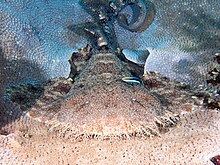Our website is made possible by displaying online advertisements to our visitors.
Please consider supporting us by disabling your ad blocker.
Tasselled wobbegong
| Tasselled wobbegong | |
|---|---|

| |
| Scientific classification | |
| Domain: | Eukaryota |
| Kingdom: | Animalia |
| Phylum: | Chordata |
| Class: | Chondrichthyes |
| Subclass: | Elasmobranchii |
| Order: | Orectolobiformes |
| Family: | Orectolobidae |
| Genus: | Eucrossorhinus Regan, 1908 |
| Species: | E. dasypogon
|
| Binomial name | |
| Eucrossorhinus dasypogon (Bleeker, 1867)
| |

| |
| Confirmed (dark blue) and suspected (light blue) range of the tasselled wobbegong[2] | |
| Synonyms | |
|
Crossorhinus dasypogon Bleeker, 1867 | |
The tasselled wobbegong (Eucrossorhinus dasypogon) is a species of carpet shark in the family Orectolobidae and the only extant member of the genus Eucrossorhinus. It inhabits shallow coral reefs off northern Australia, New Guinea, and adjacent islands. Reaching 1.8 m (5.9 ft) in length, this species has a broad and flattened body and head. Its most distinctive trait is a fringe of branching dermal flaps around its head, which extends onto its chin. The fringe, along with its complex color pattern of small blotches and reticulations, enable it to camouflage itself against the reef environment.
During the day, the solitary tasselled wobbegong can generally be found lying inside caves or under ledges with its tail curled. Individual sharks tend to remain within a local area and have favored resting spots. While resting, it opportunistically ambushes nearby fish and invertebrates, and also lures in prey by waving its tail to mimic the appearance of a small fish. At night, it emerges and actively forages for food. This species is aplacental viviparous, though little is known of its life history. The tasselled wobbegong has been reported to bite and kill humans unprovoked, although such has only been reported once in 1940[3]. The International Union for Conservation of Nature (IUCN) listed this species as Near Threatened in 2003, as outside of Australia it is threatened by fisheries and habitat degradation. As of 2015, its IUCN status is Least Concern.
- ^ Huveneers, C.; Pillans, R.D. (2015). "Eucrossorhinus dasypogon". IUCN Red List of Threatened Species. 2015: e.T41873A68623121. doi:10.2305/IUCN.UK.2015-4.RLTS.T41873A68623121.en. Retrieved 12 November 2021.
- ^ Cite error: The named reference
compagnowas invoked but never defined (see the help page). - ^ Cite error: The named reference
whitleywas invoked but never defined (see the help page).
Previous Page Next Page



